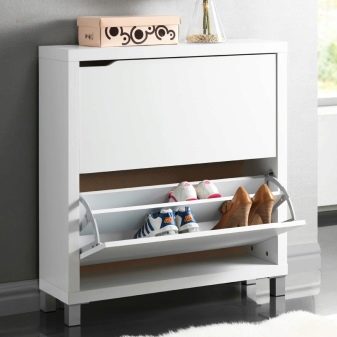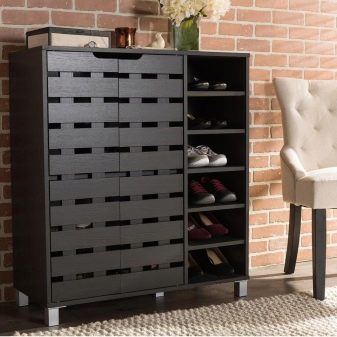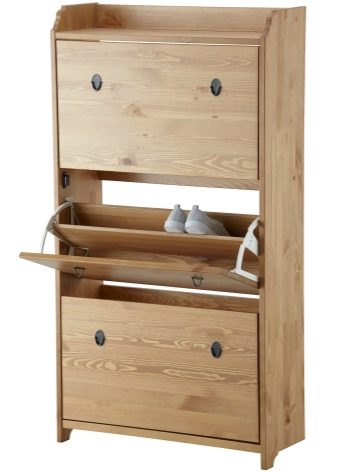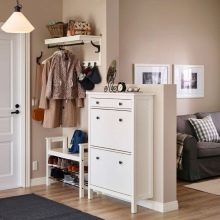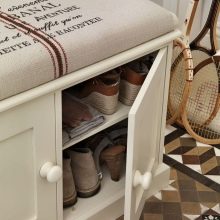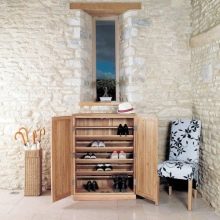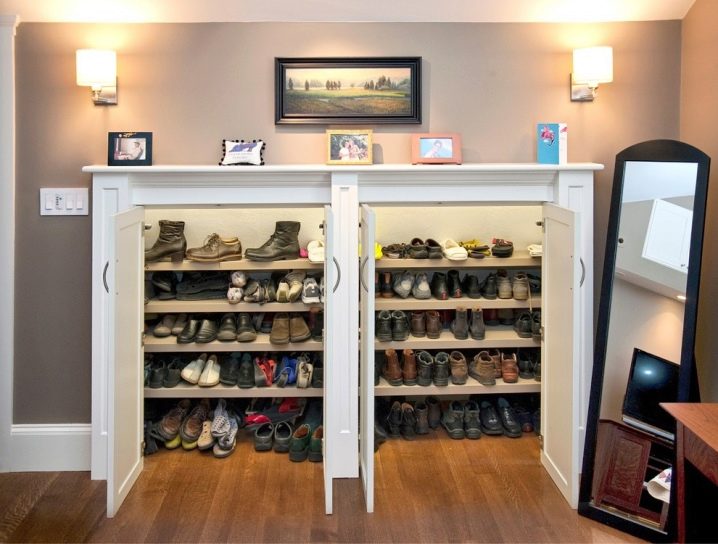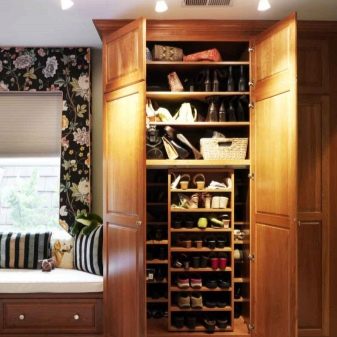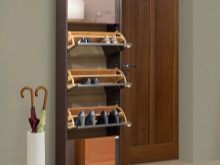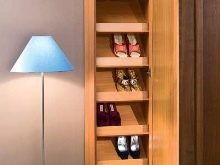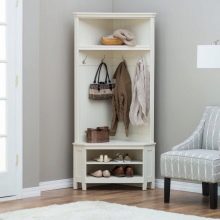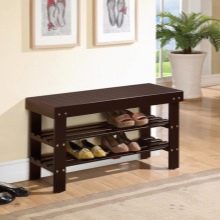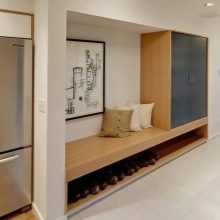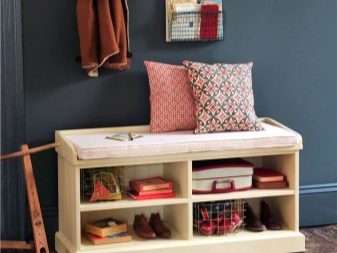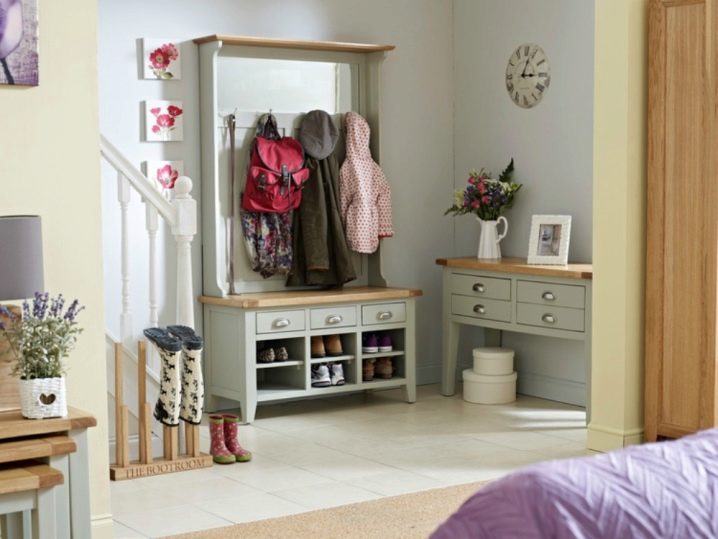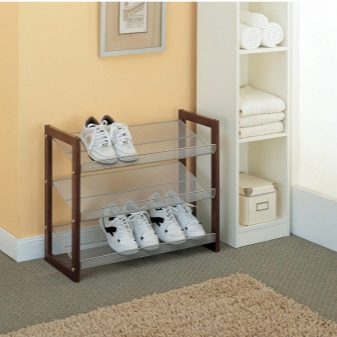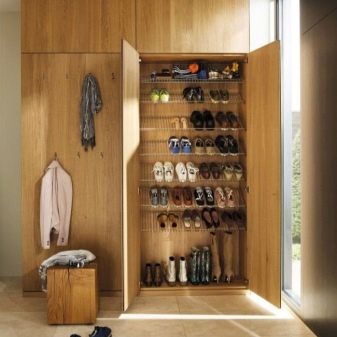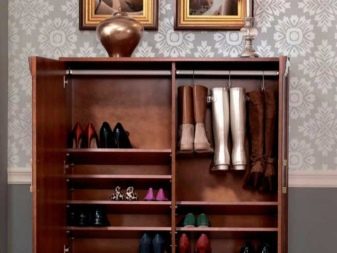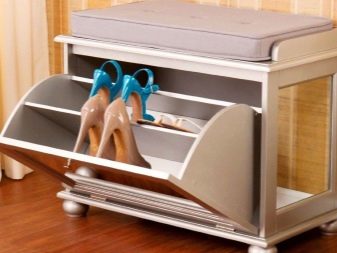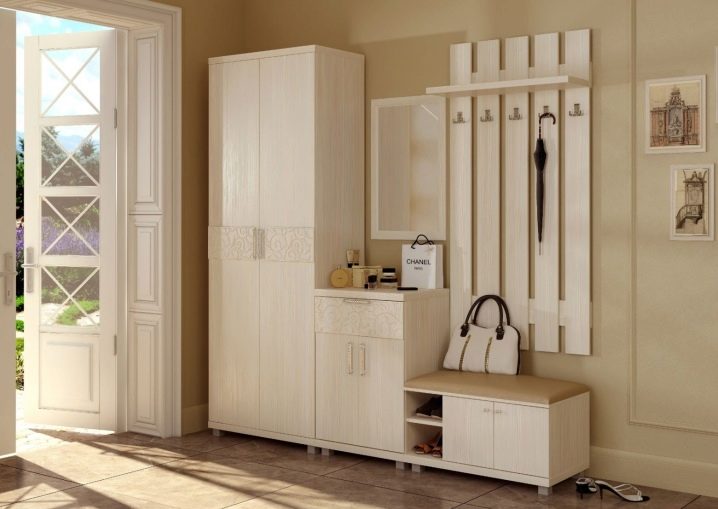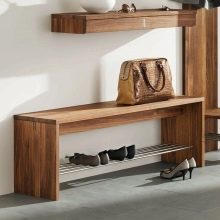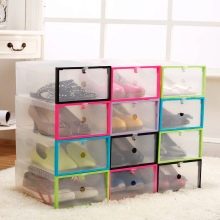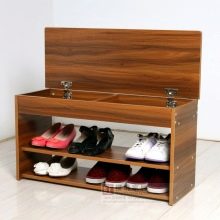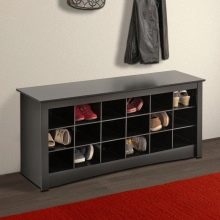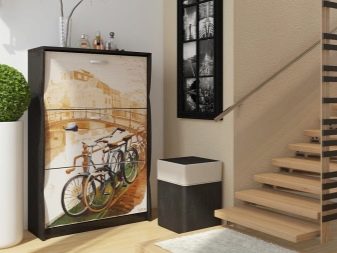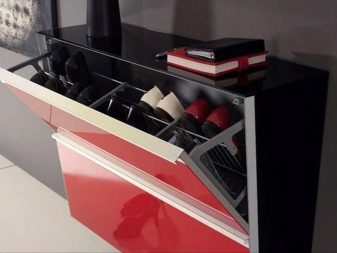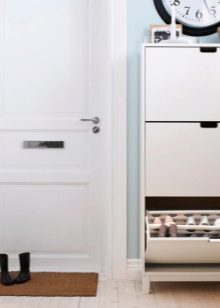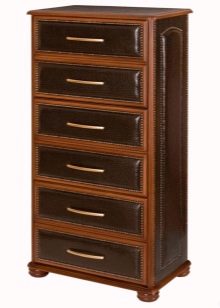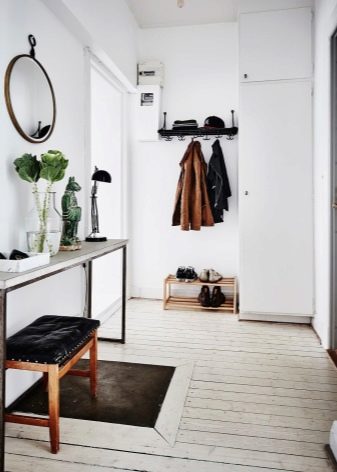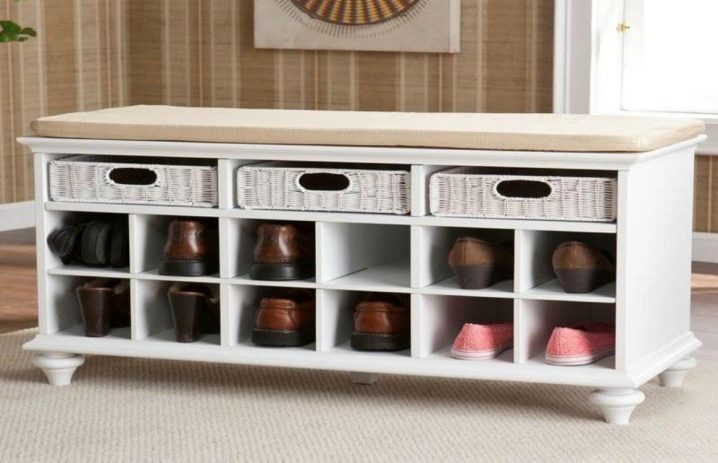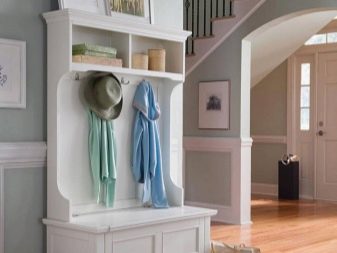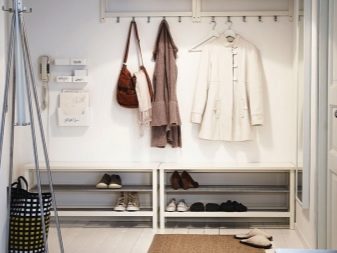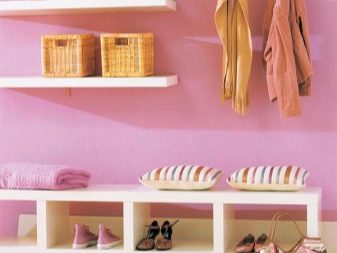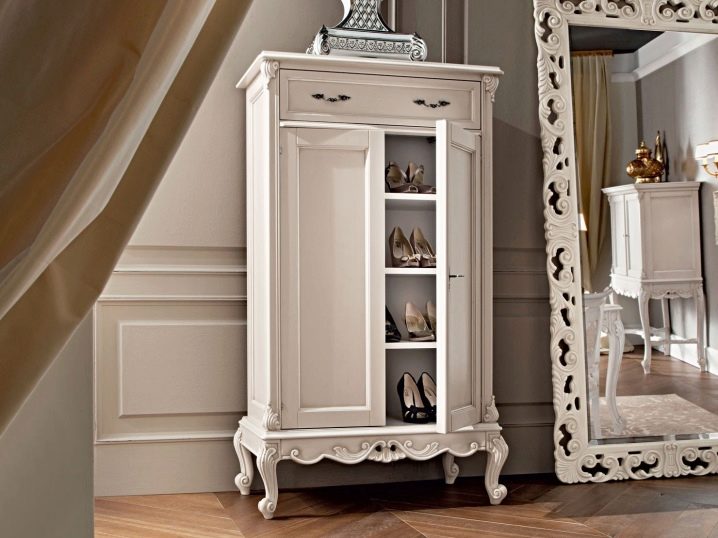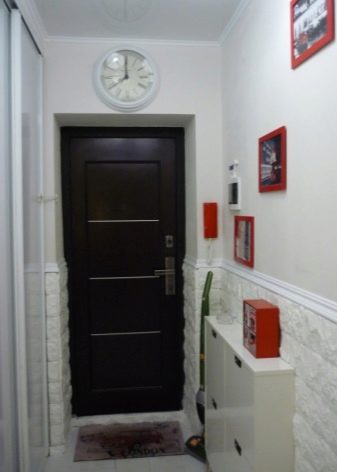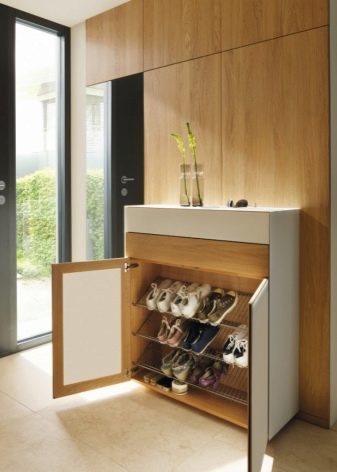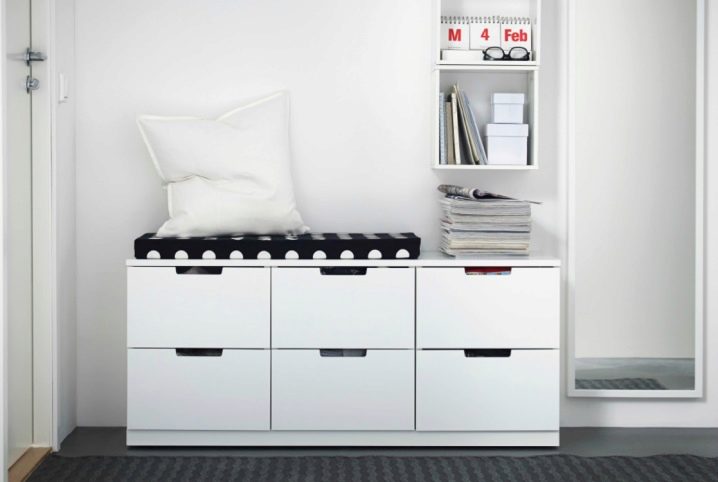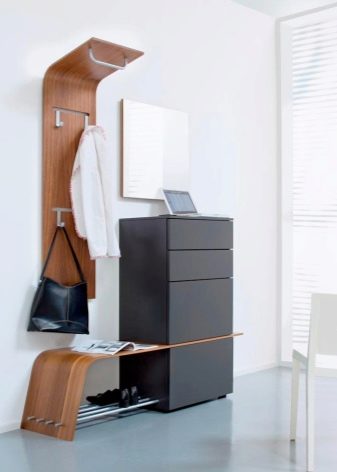Shoe store in the hallway
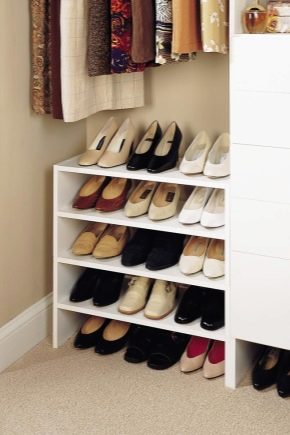
The hall is a business card of any house, whether it be a country cottage or the apartment. The general impression of the owners of the house will depend on how properly its space will be organized. And to help in arranging the area where the guest or the owner of the house falls, crossing the threshold, helps such a piece of furniture as a galore shop.
The galoshnitsa, or it is also called the obuvnitsa, represents the open or closed locker for storage of street and house footwear. By the way the galoshnitsa looks like, one can judge the character of the owner, his taste and prosperity.
Features and benefits
Initially, the shoe was designed to store only such shoes as galoshes. According to one version, they were invented by Indians to walk in them in wet weather. They made them out of rubber.
According to another version, galoshes appeared in England. They were invented in order to put on expensive shoes in wet and slushy weather. When these products became widespread, there was a need for a piece of furniture for their storage - a galoshnitse or galoshnitse. Since almost no one wears galoshes today, the shoe is now used to store any kind of shoes.
To put or not to put a slip-on shoe in the hallway depends on the homeowner himself.
A number of facts speak in favor of this piece of furniture:
- This furniture accessory for storage allows you to create a more aesthetic appearance in the room. Numerous pairs of shoes standing in rows will not catch the eye, and if there are children in the family, the shoes can also wallow in disarray.
- A special shelf for footwear allows you to save space in the hallway, since it seems to merge with the wall at the expense of a small depth. And, if the entrance area still has small dimensions, the galoshnitsa will simply be a “magic wand” for such a room.
- Such furniture for storing outdoor and home shoes is very convenient to use. Depending on the configuration, shoes in it can be stored both horizontally and vertically, and can hang on special holders.
- Being in a galoshnitse, the footwear is protected from influence of dust, moisture. In addition, here it is not available for pets that can tear or scratch it.
The main feature of the galoshnitsya is that it is an interior item, equipped with several shelves (drawers, holders), standing one above the other, due to which a large amount of shoes can be placed in such a locker.
Kinds
Today, furniture manufacturers offer a wide range of shoes - from simple low-cost models to very sophisticated and expensive. All the variety of lockers for shoes can be divided into several groups.
The shape of such products differ in a variety of designs:
- Cabinets wardrobe. This cabinet is also called cabinet-bona. This is a fairly massive piece of furniture in which you can fit shoes for all seasons of all family members. This shoe storage system is more suitable for spacious hallways and dressing rooms.The height of the shelves in the cabinets can be adjusted as desired. It is possible for each family member to allocate a separate section of such a cabinet. The doors here can be hinged or sliding, solid or with glass. The disadvantages of a galley box are that sometimes it is difficult to get the necessary shoes from the upper shelves, as well as the lack of ventilation.
- Caloshelica is a medium height shelving with shelves open design. Due to its modest dimensions, this cabinet is perfect for a small hallway. It will be easy to place all the seasonal shoes in it.
- Bowl Commode or the slim shoemaker is equipped with tilting openable drawers, which are a tray with sides, where shoes are stored vertically. The drawers can be equipped with crossbars for storing shoes with heels and are arranged in one or two rows depending on the width of the locker. Such dressers have a shallow depth, while the drawers can open 45 or 90 degrees, the Obuvnitsa Slim is an ideal solution for small entrance zones (they can be placed even behind the door). The disadvantage of such galoshnits is the impossibility of storing large quantities of shoes and the lack of ventilation.
- Caloshenny case - This is a narrow vertical design, in which you can store seasonal shoes on the shelves.
- Pendant galler box. This is a convenient narrow design that attaches directly to the wall. Due to this, under it remains free space, which can also be rationally used (for example, guests who came to the house can put their shoes here).
- Caloshelno-shelf - open design, between the posts of which one or several shelves are placed, which can be solid or in the form of a lattice. Such furniture is suitable for the storage of everyday shoes, but at the same time it does not fully solve the aesthetic and functional tasks facing it. Firstly, all the shoes are not hidden from the eyes, and secondly, it gathers dust on the shelf and can become a “prey” for pets.
- Angle Powder - Shoe storage, which can be placed in the corner of the hallway. Of course, in this design it is unlikely to be able to place a large number of pairs, but for casual shoes this would be a suitable solution.
- Caloshenica couch It is a kind of bench with a seat, under which are open or closed shelves for storing shoes or special shoe boxes.Another variant of this design is a sandbox-chest when the seat rises and under it is a drawer for storing seasonal shoes. A couch bag with a seat is very convenient in that you can sit on it by wearing shoes (this is especially true for families with children and the elderly). The lack of such furniture for storage is its small height, because of which it is possible to place not too many shoe sets in it.
- Stand for footwear allows you to store shoes in the open form in the same row. Stands are made from a variety of materials, can be made in any design, so harmoniously fit into any interior.
According to the degree of openness, galoshnits can be divided into closed and open products.
- Open constructions. These include galoshes in the form of shelves, shelves, coasters. The undoubted advantage of such storage systems is that their shoes are well ventilated, dry in natural conditions, and do not accumulate odors. Shoes on the shelves do not pollute the floor, the shelves themselves are easy to clean. The disadvantage of open shoe cabinets is that the shoes are visible, sometimes creating a feeling of confusion.
- Closed constructions. These include cabinets, dressers, pencil cases, that is, all those galoshnits, shoes in which are closed from prying eyes doors, drawers and other devices. The main disadvantage of closed systems is the lack of ventilation, which leads to the fact that shoes can not completely dry out and, as a result, smell bad.
Addition
Modern manufacturers of cabinet furniture offer their customers not only galoshnitsya in its pure form, but also combined designs, for example, with a hanger. So, in the lower part there can be a locker for storing shoes and shoe accessories, and in the upper part - an open clothes hanger or a closed compartment with a rod and outerwear hooks. The baller box may be with a mirror, which will also be located at the top of the structure.
Dimensions
Dimensions of galoshes can be very different - from high and bulk wardrobe cabinets to minimally-sized stands for shoes. It all depends on the size of the room where the shoebox is selected and the number of pairs of shoes that it must fit. If you need to keep all the shoes of the family for all seasons, the wardrobe will be quite impressive sizes.If you need furniture to store everyday shoes, you can get by with a small galoshnitsa, choosing its depth and height, depending on the size of the room.
The standard (optimal) depth of the shoebox is 60-80 cm. If the dimensions of the hallway allow, you can choose an option with a greater depth - for example, 120 cm. For the usual medium-sized hallways, galley shoes are suitable with a depth of 40-50 cm, and for very tiny entrance zones You can find models with a minimum depth of 13-18 cm.
A galosh can be: low - 1-2 shelves, medium, with 2-4 shelves, and high, which includes more than 4 shelves.
The width of the shoe depends on the availability of free space in the entrance area. In some cases, a large amount of shoes can be placed in fairly narrow and low lockers by increasing their width.
Materials
The service life of a galite and the convenience of its use are more dependent on the material from which it is made. Now you can find the galoshes made of the following materials:
- Solid wood. Products from this material are distinguished by good quality and beauty. Best of all, they will look in classic and ethical interiors and spacious hallways. For such furniture requires more thorough care.To preserve the good appearance of the wooden shoebox, you will need to regularly treat it with special compounds. In addition, only clean shoes can be put in such a shoebox;
- Metal. Forged metal galoshnits strong and durable. They are suitable for interiors in the style of minimalism or high-tech. Forged shoeboxes look stylish and interesting. Sometimes you have to paint them to protect the iron elements from corrosion. Choosing such products, you should pay attention to the thickness of the metal. If the shelves are too thin, they can bend under the weight of the shoe;
- Plastic. The cheapest stuff. Plastic shoes are easy to clean, but not very durable - plastic parts can break off or be scratched. This piece of furniture is not suitable for any interior;
- Chipboard - the most common material for the manufacture of furniture. Handbags from a chipboard are simple in leaving, are made in different colors and models. The disadvantage of Chisinau shoes is their fragility - under the influence of moisture, they can be deformed.
- Rattan. Woven galoshnits well suited for interiors in country style.The advantage of such a locker for shoes is the presence of ventilation in it, which is provided by the structure of the material used for its manufacture. Shoes in such a fake shoe will always be dry.
- Glass. Glass designs look original, but very difficult to clean, since dirt, dust, and hand marks are clearly visible on glass surfaces.
Color options
Color solutions for galoshnits are very diverse. Depending on the stylistic orientation and color solution, you can always choose the desired model.
Products from chipboard assume the widest choice of color solutions - from various shades of wood to bright colors (red, blue, green and others). Plastic cabinets also have a wide range of colors (from white to black). A wrought iron shoe is most often metallic in color (silver, gold, platinum), white or black.
Brands
Obuvnitsa produced as large furniture manufacturers, such as "Furniture Black Earth", "Dyatkovo", "Vesta", "Glazov furniture factory", "Shatura-furniture", "Tria", "Lazurit", "Soyuzmebel" and others, and small companies, as well as custom-made in furniture workshops.
Quite a lot of options for lockers for the storage of shoes presented in the line of the Swedish company Ikea.
How to choose furniture and where to place?
Usually a galley is purchased when the overall interior decoration of a room has already been completed. And therefore this piece of furniture should organically fit into the style, color, and functional features of the room.
Choosing one or another version of the locker, you must consider the following factors:
- Dimensions of the entrance area;
- The space allocated for caloshes (width, height, depth);
- Family size, the presence of children;
- Do guests often come;
- Family member habits;
- The presence of pets;
- Shoe size.
The hardest thing is to find a galoshnitsy for a small room. After all, it will have to accommodate the maximum possible number of pairs of shoes, but at the same time its place should be minimal. For such a hallway fit narrow, but tall lockers (with fastening to the wall) or stands for shoes. A good option would be a shelf on wheels, which, if necessary, can be easily moved.
When choosing a system for storing shoes, you also need to pay attention to the presence of shelves for various types of shoes: for high boots, for shoes with heels.
The traditional placement of the pouch is along the wall closer to the front door to remove shoes and immediately put them in the locker, without cluttering the hallway, especially if it is small. But it is also possible to place across in order to separate the hallway from the rest of the space.
In private houses with two or more floors, sometimes galoshnitsu equip in the space under the stairs.
Unusual interior solutions
The wooden tedder is also a seat and a chest of drawers. The design is equipped with wicker drawers for small items and fits perfectly into the modern interior.
The original solution for compact storage. In one piece of classic design, the galoshnit, the seat, the clothes hanger, and the shelves were connected.
Open shelf for shoes in the best traditions of minimalism. She also acts as a pouf for comfortable putting on shoes.
It is difficult to understand that this is a system for storing shoes. Once in this room, it seems that you are already in the ladies' boudoir, and not in the hallway.
A narrow expensive shoe built into the wall does not clutter an already narrow hallway, but at the same time it contains everything you need.
The spacious storage system, which also serves as a seat, is almost invisible in the entrance area, thanks to the white color that supports the overall color scheme of the room.
Thanks to the use of compact black plastic shoe modules from Ikea, the shoes of all family members were placed in a small hallway. Under the galley box, the stool successfully fitted in for the children to put the shoes on comfortably, and additional shelves formed between the modules and above them.
In the next video you are waiting for a lot of ideas Obuvnits in the hallway.
